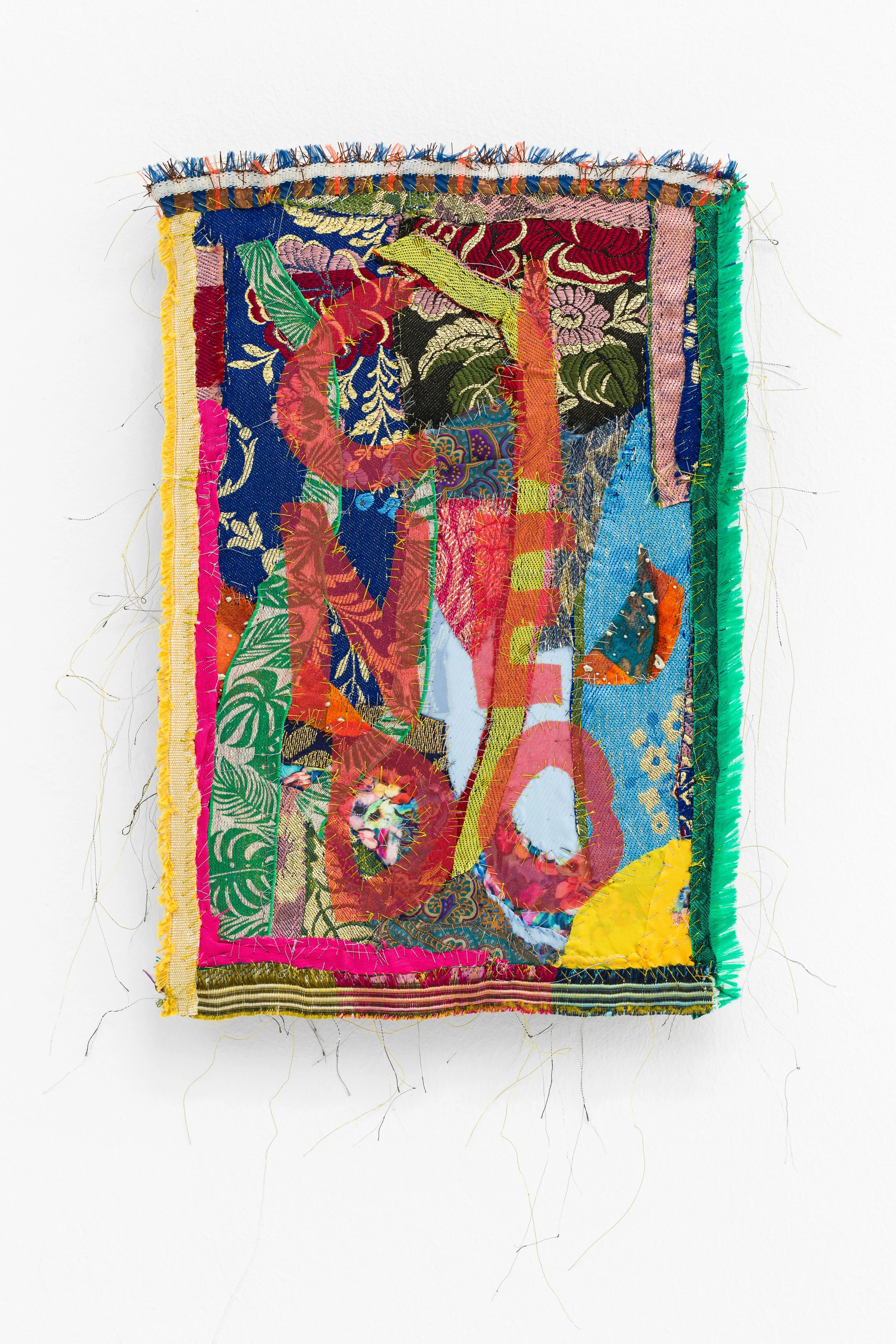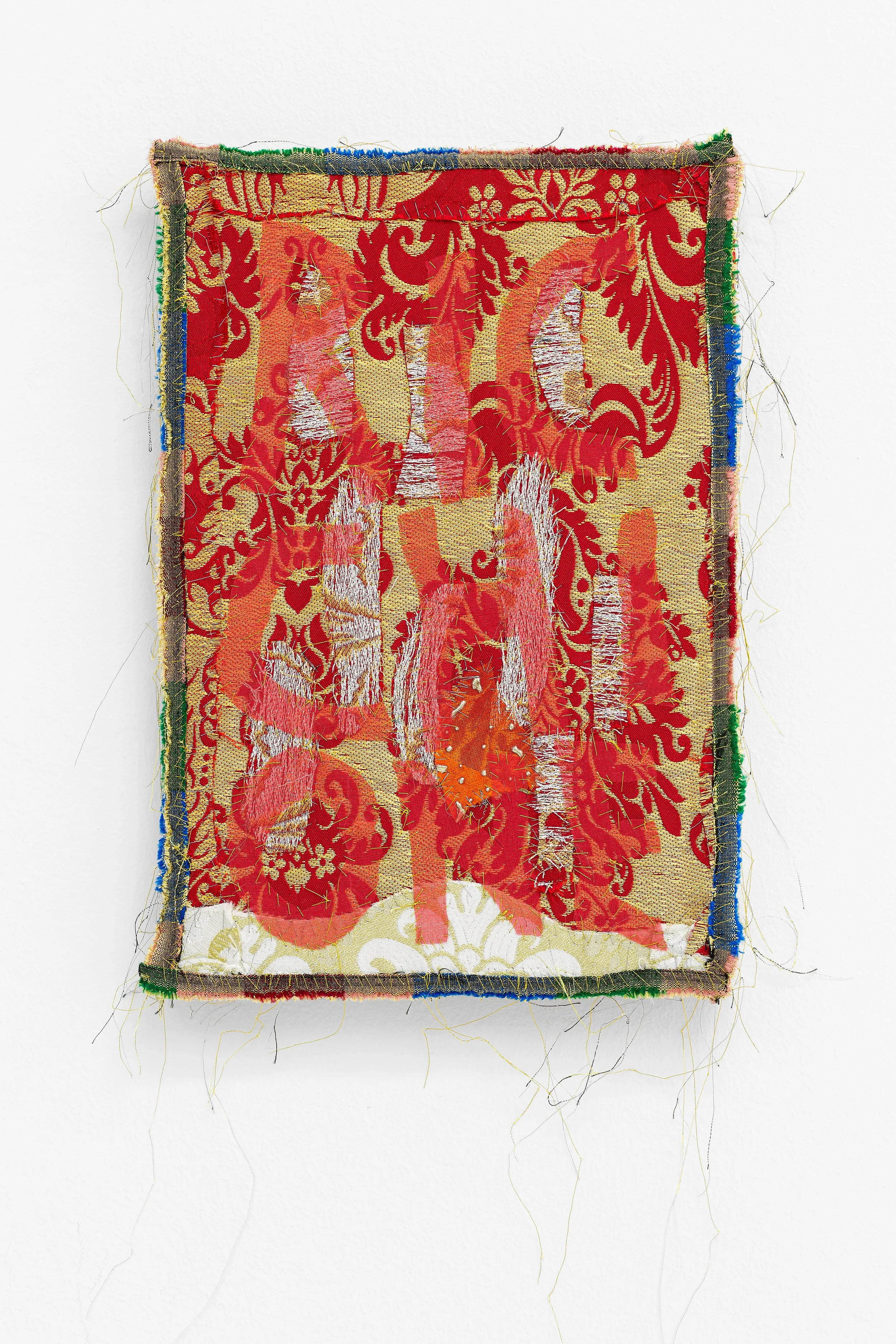LAME, 2020-2021
Lame (Blades), 2020-2021
A work made of 50 elements
20 x 30 cm each
Sardinian brocade, fabrics from artist’s own clothes, silk organza, metallic thread, stitched on canvas
ph Nicola Morittu
Documentation of the exhibition at Prometeo Gallery, Milan
With an essay by Eugenio Viola
In a dialogue with some works of Nicolò Bruno, Prinz Gholam, Karol Radziszewski
ph Ela Bialkowska, OKNOstudio
The tongue kills more than the sword - Qui gladio ferit gladio perit
In the last fifteen years, Ruben Montini’s research has been developing coherently by directly attacking the heteronormative stereotypes linked to sex, sexual orientation and gender identities. He has been facing uncomfortable, yet current and critical subjects, by using performance as the preferred medium. These characteristics have determined the outcomes of a precise aesthetic strategy, which has marked the research of such a complex artist in the world of Italian performance art.
Through the exhibition of his own naked body, flaunted, tattooed, humiliated, and sometimes wounded and bleeding yet glorified, Montini has enacted his Passion, his secular martyrdom. A Via Crucis composed of actions that reveal the topography of an imperfect body, a desacralised Ecce Homo. Montini has engraved on his body the traumas, the pain, and the sufferance the Social Body inflicts on people who are considered ‘different’. It is a foundational part of his work, almost a part of his destiny.
In Montini’s oeuvre, the artist’s body coexists with the residues celebrating his body’s absence: performance, photography, and video, together with painting, drawing, installation, and embroidery, mixed with the residual traces of the actions themselves.
Embroidery is central in Montini’s multifaceted artistic vocabulary. He recontextualizes an activity usually connected to women’s duties and often relegated to the “minor arts” while turning it into a tool able to celebrate, ironically and polemically, the subversion of socially accepted norms, as it often happens in the artist’s work.
L’Amore Indicibile [The Unspeakable Love], 2021, whose title recalls the famous yet painful definition by Oscar Wilde about the Love that dare not speak its name, is an amateur photograph that portrays one of the artist’s intimate moment, erased by an intricate embroidering in gold thread which deletes the other person. Montini creates an image that avoids the failures or idealisations of memory, but still preserves a highly evocative potential.
This work can trigger memories, create an alienating short-circuit between the instant of the gaze and the moment captured by the image. It is even possible to imagine an intimate moment of the artist’s private life that uncovers conflicts and contrasts. Memory and moments of life reveal themselves in their spontaneity, while offering a pompous and lascivious intimacy. The scene is constantly waiting for an intrusion by the spectator, who takes the privileged place of the trespassing into an arena where he will inevitably be an intruder, a consumer by proxy.
Montini has always used his body as a map of signs, a place to engrave cruel actions alternated to private, intimate moments. Se non uccide fortifica [If it does not kill, it makes (you) stronger], 2020, is a performance the artist realises for the launch of CONFINO, his recently opened artist-run space, whose mission is to exhibit young LGBTIQ+ artists living in Italy . In this action, Montini tattoos on his arms the mangling of his name in the female “Nicoletta Rubenitta” (from Nicola Ruben), the nickname used by his classmates, to mock his effeminate manners. As it often happens in Montini’s modus operandi, the work narrates an autobiographic episode rooted in the artist’s childhood. This work recalls one of Montini’s first performances Frocio [Faggot, 2009], a title that reflects a more aggressive offense than the ironic “finocchio”, whose politically correct counterpart “gay”, is a neologism deriving from a historic sign of self-determination connected to the post-Stonewall movement in the United States: “Good as You”. In this action, the artist reacts to the homophobia that characterised, and still characterises, much of Italian society. While I am writing this, in Bogotá, I hear the echoes of the debates over the approval of the DDL Zan, a law against homo/bi/transphobia, stuck at the Italian Senate between pressings, oppositions and a divided parliamentary majority.
These two works are a testimony to how Montini has always attacked public morals, the so-called common sense; they also reveal a more politically engaged side of the artist. Frocio is a work conceived in dialogue with Regina José Galindo’s Perra [Bitch, 2005], where the artist, during a dramatic performance, carves with a knife the slur “perra” (bitch) on her left leg, recalling the morbid practice of engraving this insult in her country, Guatemala, as a sign of utmost contempt, in the flesh of the women raped and killed. Both works, just like the more recent Se non uccide fortifica, recall, without any rhetoric, that the human being, beyond the issues around gender, is always on the verge of submission and contempt. Both artists often renounce the Baudrillardian strategy of seduction to adopt the submissive one, uncomfortable both for them and for their audiences. Regina protests the barbaric practice of femicide with a work of invective, whose structure is assimilated in Montini’s oeuvre and repurposed in two works that, after years, affirm LGBTQ+ pride.
Finally, Lame (Blades, 2021), the title piece of the exhibition, constits of 49 works on canvas, where the artist has embroidered all the homophobic insults from the Italian language and all the country’s dialects. They are cut in red organza and embroidered in Sardinian brocade, lace, velvet, and other fabrics. These works, whose lavish appearance clashes with the message they represent, are exposed in a dialogue with works by Nicolò Bruno, the duo Prinz Gholam, and Karol Radziszewski. Their works portray scenes of homosexual love, like Prinz Gholam’s PG Monogatari [undressing] and PG Monogatari [public garden] (2021), and Nicolò Bruno (Love Story, 2013, and Nella buona e nella cattiva sorte [In good and bad luck, 2021]). Karol Radziszewski also shows a work that, like in the case of Montini, lends itself to autobiography: Self-portrait, from the series “1989” (1989/2019), in which the Polish artist depicts himself as a child dressed as a princess. A child that has surely been burdened, like Montini during his childhood, by homophobic slurs, of which Lame constitutes an uncanny archive. After all, as the old saying goes, “the tongue kills more than the sword”. In this sense, Lame sounds like a true declaration of war to respectability, bourgeois hypocrisies, and conformism. A war that Ruben Montini has taken on with his work, with awareness, for several years, one that he has continued, uninterruptedly, until today.
Eugenio Viola, Chief Curator Museo de Arte Moderno de Bogotá - MAMBO, Bogotà, Columbia











